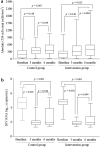Effect of mobile text messages on antiretroviral medication adherence and patient retention in early HIV care: an open-label, randomized, single center study in south Florida
- PMID: 32404130
- PMCID: PMC7222430
- DOI: 10.1186/s12981-020-00275-2
Effect of mobile text messages on antiretroviral medication adherence and patient retention in early HIV care: an open-label, randomized, single center study in south Florida
Abstract
Background: People with HIV (PHIV) with limited access to health services often experience suboptimal antiretroviral therapy (ART) adherence. We investigated whether a daily text messaging intervention improves ART adherence and retention in early HIV care in PHIV in a south Florida hospital-based clinic.
Methods: ART-naïve PHIV receiving care through the clinic's Ryan White HIV/AIDS Program were enrolled and randomly assigned to the intervention or control groups with a 1:1 ratio. The intervention group received a 1-way text message daily and the control group received standard care without receiving text message reminders for 6 months. HIV RNA and CD4 cell count were measured at baseline and post-intervention. Adherence to ART was defined as a visual analog scale of ≥ 90%. Retention in care was defined as continued engagement at study end.
Results: 94 ART-naïve patients were randomized and 83 (85.6%) completed the study, of which 44 were in the intervention group and 39 were in the control group. At the end of the 6-month study period, adherence to ART was 84.4% in the intervention group versus 73.5% in the control group (OR, 1.9; 95% CI 0.7-5.0; p = 0.194). Retention in care significantly improved in the intervention group compared to the control group with the odds of retention increasing by 20% (OR, 1.2; 95% CI 1.1-1.5; p = 0.006). Undetectable HIV RNA (< 50 copies/mL) was 86.7% in the intervention group versus 73.5% in the control group (OR, 2.3; 95% CI 0.8-6.9; p = 0.112). A significant increase in CD4 cell count and a decrease in HIV RNA were found at study end, with no differences between the two groups.
Conclusions: In this pilot study, a one-way daily text messaging intervention did not improve ART adherence over a 6-month study period, but significantly enhanced patient retention in early HIV care. Implementation of interventions to improve adherence in this population is required.
Keywords: HIV; Medication adherence; Mobile health; SMS; Text message.
Conflict of interest statement
The authors declare that they have no competing interests.
Figures



Similar articles
-
Attitudes, Beliefs, and Willingness Toward the Use of mHealth Tools for Medication Adherence in the Florida mHealth Adherence Project for People Living With HIV (FL-mAPP): Pilot Questionnaire Study.JMIR Mhealth Uhealth. 2019 Jul 3;7(7):e12900. doi: 10.2196/12900. JMIR Mhealth Uhealth. 2019. PMID: 31271150 Free PMC article.
-
A differentiated digital intervention to improve antiretroviral therapy adherence among men who have sex with men living with HIV in China: a randomized controlled trial.BMC Med. 2022 Oct 10;20(1):341. doi: 10.1186/s12916-022-02538-3. BMC Med. 2022. PMID: 36210434 Free PMC article. Clinical Trial.
-
A Randomized Controlled Trial of Real-Time Electronic Adherence Monitoring With Text Message Dosing Reminders in People Starting First-Line Antiretroviral Therapy.J Acquir Immune Defic Syndr. 2015 Dec 15;70(5):495-502. doi: 10.1097/QAI.0000000000000770. J Acquir Immune Defic Syndr. 2015. PMID: 26218411 Clinical Trial.
-
A Systematic Review of Mobile Phone Interventions (SMS/IVR/Calls) to Improve Adherence and Retention to Antiretroviral Treatment in Low-and Middle-Income Countries.AIDS Patient Care STDS. 2020 Feb;34(2):59-71. doi: 10.1089/apc.2019.0181. AIDS Patient Care STDS. 2020. PMID: 32049555
-
A systematic review and meta-analysis in the effectiveness of mobile phone interventions used to improve adherence to antiretroviral therapy in HIV infection.BMC Public Health. 2019 Jul 9;19(1):915. doi: 10.1186/s12889-019-6899-6. BMC Public Health. 2019. PMID: 31288772 Free PMC article.
Cited by
-
Comparison of machine learning models to predict loss to follow-up among people with Human Immunodeficiency Virus (HIV).JAMIA Open. 2025 Jul 24;8(4):ooaf077. doi: 10.1093/jamiaopen/ooaf077. eCollection 2025 Aug. JAMIA Open. 2025. PMID: 40709239 Free PMC article.
-
Does telehealth affect the adherence to ART among patients with HIV? A systematic review and meta-analysis.BMC Infect Dis. 2023 Mar 17;23(1):169. doi: 10.1186/s12879-023-08119-w. BMC Infect Dis. 2023. PMID: 36932376 Free PMC article.
-
Brief communication: Effect of mobile health intervention on medication time adherence among people living with HIV/AIDS receiving care at selected hospitals in Owerri, Imo State Nigeria.AIDS Res Ther. 2024 Oct 24;21(1):75. doi: 10.1186/s12981-024-00653-0. AIDS Res Ther. 2024. PMID: 39449012 Free PMC article.
-
Effectiveness of mHealth on Adherence to Antiretroviral Therapy in Patients Living With HIV: Meta-analysis of Randomized Controlled Trials.JMIR Mhealth Uhealth. 2023 Jan 23;11:e42799. doi: 10.2196/42799. JMIR Mhealth Uhealth. 2023. PMID: 36689267 Free PMC article. Review.
-
PrEP discontinuation among Latino/a and Black MSM and transgender women: A need for PrEP support services.PLoS One. 2020 Nov 5;15(11):e0241340. doi: 10.1371/journal.pone.0241340. eCollection 2020. PLoS One. 2020. PMID: 33151997 Free PMC article.
References
-
- US Centers for Disease Control and Prevention. Understanding the HIV care continuum. https://www.cdc.gov/hiv/pdf/library/factsheets/cdc-hiv-care-continuum.pdf. Accessed 2 Oct 2019.
Publication types
MeSH terms
Substances
LinkOut - more resources
Full Text Sources
Medical
Research Materials

